


Last Update: 06/06/2017
[ Wirelessnotes Home | Interpage Home | Mechanical Failures | WMATA/DC Metro Service/Infrastructure Issues | Verizon DC Metro Drop Map | Cellular Comparison of US Carriers | Cellular Voice Delays/Latency | Verizon Cellular Dropped Call List | Verizon Data Call Drops | Nextel Drop List | Sprint Dropped Call List | AT&T Wireless Dropped Call List | T-Mobile Dropped Call List | Contact us ]



|
Disclaimer/Note: The authors have no
relationship with Washington DC Metro Rail other than as customers who
appreciate a nice and quiet train ride, with the comfort and surroundings
not commonly afforded on most US mass-transit systems. Removing 1000/2000
series cars and replacing them with less comfortable 7000 series
cattle-cars similar to the NYCTA R-143/160 series (which appear to be
designed more to be able to quickly hose them down after the cattle
(passengers) have left rather than based on passenger comfort (as the
R-44/46 and to a lesser extent R-68 cars were) is not the
best way to encourage and build ridership, especially in non-commute
hours. A boxcar does not a pleasant ride make (not to mention the
increased noise from lack of carpets, seat padding, and door screens) and
it appears that WMATA is once again promoting their convenience
at the expense of customer comfort.
Stop WMATA/DC Metro From Implementing Inferior Interior Accommodations on 7000 Series Rail Cars
Well, now that we're in May, 2017, it's kind of hard to "stop"
WMATA/Metrorail from "implementing" the garish interiors on
their new 7000-series rail cars, as the cars are currently in service.
Yet despite Metro's typically hyperbolic promotion of the 7000-series cars
as more modern and superior to the older rolling stock, it's become
obvious that at least some of the concerns articulated on this page over
the past three years have generally been on target (we could also say
"on track", but we wouldn't do that!), such as the noisier ride
(likely due to the lack of carpeting and soft paneling on the upper walls
and ceilings), unpleasant interior (looks like a transport van with
seats), lack of full-length door-screens (allows cold, heat, wind, and
rain to come in to the car and affect passengers seated near the doors),
unpleasant lighting (Light Emitting Diode/LED lights are fine for
street lights, but not the interior of a train!), and
computerized-announcements which sound like they were generated on an
Apple II+, to name a few.
Indeed, much to our surprise, no less than The Washington Post
referenced this page in an article on April 5th pertaining to the
aforementioned LED lighting, where the Post compared the 7000-series
interior lighting to
that of the interior of a Xerox machine!. (They also referred to this
page as a "rant", the online, contextual definition of which
eludes us... This isn't a rant by any means -- if they want to
hear a rant and have at least three hours to spare (and/or need
to cure insomnia) then by all means call us and they'll get a rant! :)
This, by comparison, is timid expository writing... ;)
In any event, and in all seriousness, there seems little at this point
that can be done to alleviate many of the passenger-convenience issues
with the 7000-series cars; let's hope that enough people complain about
the significantly noisier ride, the slippery floors, the Xerox-machine-like
lighting, primitive computerized announcements, and the overall feeling
that standards are being lowered to save WMATA some money, so that the
next batch of cars can hopefully remedy these significant flaws and
downgraded passenger amenities.
Additionally, besides the passenger comfort issues which promulgated this
posting, the Kawasaki 7000 series cars have also been experiencing an
inordinate number of technical failures, beyond those of a typical
"weaning in" period for new rolling stock, such as a significantly
higher mean distance between failure (MDBF) and other passenger movement
difficulties, 7000-series
cars separating in revenue service with passengers on board, and externally
causing problems with Metro's tracks due to the greater weight of the 7000
series cars (and causing more noise and vibration for nearby
residents). A prior WMATA manager also appears to agree that
Metro should have continued to have regular purchases of the established
car models.
At the very least, hopefully this can serve as a reminder that WMATA
seemingly puts passenger convenience way below costs, so that when the
8000(?) series bids take place, while WMATA will likely patronize the
ridership with patently ridiculous claims of the superiority of the
passenger amenities of their new rolling stock as they did with the 7000
series, the riding public can use this in some small way as a resource to
see that they are yet again being sold a bill of goods, which hopefully they
will decline to accept unless significant changes are made to address the
deficiencies of the 7000 series rail cars.
Post prior to May 2017, with some updates as needed:
WMATA has announced plans to implement Spartan interiors on the new the
7000 series cars in the Washington DC Metro subway system to replace the
1000 (and 2000?) series cars. As evidenced in the photos below, the 1000
(and 2000-4000) series cars include cushioned seats, carpeted floors and
door screens to reduce noise and enhance the comfort of passengers seated
near the doors. 5000 series cars have fewer door screens, and 6000's have
only partial (generally useless) door screens (they are only partial and
people at the doors can lean onto seated passengers bodily and/or with
their belongings). Additionally, four 6000 series cars (also pictured
below) have no carpeting at all and offer a markedly noisier ride.WMATA/DC
Metro has also recently indicated that they wanted to remove carpeting
from all Metrorail cars so as to make it easier to hose them down
after the oxen (eg, the riding public) have left for the evening!
After riding on a few 7000 series trainsets, we've identified the
following passenger-comfort/esthetic concerns with the interior:
Have some of the carpets gotten old and stained? Sure...but that's what
happens if you don't clean/repair/replace them. Are cushioned seats more
expensive than the "hard cloth" seats of the 7000 series (similar to some
NYCTA articulated busses with "no slide" seats)? Of course, but passenger
comfort costs more than amenities provided for cattle and barnyard
animals! Do door partitions, along with the carpets and padded seats, help
to absorb the at times exceedingly loud tunnel noise which WMATA trains
make (due to the slightly less than standard track gauge)? Yes, and that's
why we still need them!
DC is not NY nor Boston and for over 35 years has stood apart from other
US transit systems by putting passenger comfort ahead of administrative
convenience in an effort to attract and build ridership. (As a side note,
NYCTA's R-44's initially had carpets (view it here), and
were much quieter, and the R-44/46s had full screens as Metro did (based
it seems on the
SOAC
subway car with this great interior!
Typical of the TA, the 46's no longer have full screens (which were
retained on the now gone 44s (except on Staten Island's SIRT)) as they are
too cheap to put the transparent plastic in the frames, and it appears
that WMATA/Metro is heading in the same direction as well).
Petty concerns about passenger comfort? Maybe in NYC, where the roads are
in such poor condition, the tolls so high, and the NYPD immunized against
errant traffic citations by a Kafka-esque administrative law
traffic court system (that circus is a whole other topic; for the curious
reader, Google New York TVB administrative traffic court
and read the horror stories; for an overview see the section labled "New
York DMV Transit Adjudication Board" in this article,
about halfway down the page), but in DC, where people have other
options (ie, driving, especially after-hours and on weekends when the town
is half-empty), and where Metro doesn't really go where a lot of people
need to go (yet...), keeping people happy and comfortable on the train is
a critical component to building ridership, and Metro is sending the wrong
signal with its continuing attempts to masquerade its perennial
self-interest in lower maintenance costs under the guise of modernity and
ergonomics.
Use the LobbyByFax system to send an
immediate fax to the the DC City Council, all of the Maryland and Virginia
WMATA jurisdictions, and the Metrorail's Administrative Office, telling
them to put passenger comfort ahead of WMATA's needs and
whims by clicking on the appropriate link below:
In addition to removing the carpeted floors, the 7000 series do not
include full partitions common in other most train cars (both in the DC
Metro as well as other rapid transit systems, such as the
"Metropolitan"/"Cosmopolitan" "M"-series of commuter rail cars used in the
NY Metro Area for over 40 years, even in today's contemporary and most
modern variants (M7, M8).
As many passengers stand by the door, the partition helps seated
passengers from feeling too crowded. Additionally, they serve as
wind/draft breaks which prevent exceedingly hot or cold outside air (in
summer/winter) from blowing directly onto passengers seated next to the
doors. The partitions/dividers also serve to keep rain, snow and the
elements out of the seating section of the car. Finally, they also serve
as a noise-break between the various sections, so that inconsiderately loud
passengers (or groups thereof) can be segregated into a given section,
minimizing their annoyance to the majority of the more considerate riders.
Besides offering a 'private section' on WMATA / DC Railcars when the
motorman's cab is not in use, the various plastic screens and partitions
on earlier model cars (as see on the the 1000, 2000, 3000 and 4000 series
WMATA railcars) also serve to set aside two seats (and in the case of the
1000 series, a 'single seat' unique to that series) immediately adjacent
to the motorman's cab area from the main car body and which also offers
some degree of additional privacy as well as a shelter from the outside
elements. Pictured below are the the two 'two seat' sections of
car 1183; the 1000/2000/3000(?)-series have them laid out length-wise along
the sides of the car, while newer series have them perpendicular to the
car body walls and parallel to the cab seats, but one row closer to the
main car body. In both cases plastic wind screens/compartment dividers
are provided to separate these seats the general car body.
By failing to provide for similar dividers (which effectively block out
the elements and noise) in the 7000 series of railcars, WMATA/DC Metro is
effectively offering a less comfortable ride for both passengers
immediately adjacent to the doors as well as the remainder in the area
near doorways.
WMATA has reconfigured a few cars from the 6000 series to approximate some
of the interior aspects of the prospective 7000 series; carpets were
removed and replaced with slippery (when wet and/or when snow is present
near the doors) vinyl/hard plastic flooring (second photo below), all
partitions and wind screens bordering the door were partial and do not
appear to offer much protection from the elements and/or other passengers
(although not as pronounced as the angled-partition in the 6000 series
pictured below). Some additional seating areas were also removed and
interior lighting was changed from soft/warm white fluorescent bulbs to cool
white fluorescent bulbs, giving the cars a pallid, factory-like, and
unwelcoming ambiance. Additionally, the tunnel noise experienced on these
"prototype" modified cars was appreciably higher and significantly more
noticeable than that of the more insulated (vis a vis carpets and door
partitions) and sound-absorbing interiors of the current, unmodified
fleet.
Note the middle door wind-screen and the lack of a partition as compared
to earlier series cars. There is no partition furthest from the camera (to
the left of the pictured doorway), and only a half-height, angled
partition on the closer side. This configuration offers very little
protection from outdoor elements for the seats located near the doors,
doesn't filter out loud/noisy passengers from other sections in the given
car, and also fails to 'buffer' seated passengers from people standing
near the doors and leaning on the partitions.
Providing full door partitions (let alone carpeting and padding in the
walls to reduce noise) seems like a relatively simple way to enhance
passenger comfort, yet WMATA staff have apparently become tired of
cleaning carpets (better to let people slip, fall, and hurt themselves on
wet vinyl??) and fixing the glass (or plastic?) door partition panels (not
that many needed fixing) in a penny-wise and pound-foolish attempt to cut
costs.
WMATA has recently begun promoting the future delivery of the 7000 series
in numerous advertisements (photo below) throughout the Metrorail system.
The typically self-adulatory prattle transparently applauds the
7000-series railcar's improvements in passenger comfort, as if the 7000
cars conferred some actual, tangible benefit to passengers, rather than
just WMATA's desire to spend less on passenger amenities. While the
7000-series may be precisely what WMATA needs/wants in terms of
saving money on cleaning cars and other associated maintenance costs,
despite WMATA's no doubt well-researched and sourced 'consumer feedback',
it is likely not what the riding public - their customers who pay the
bills want, but why should WMATA concern themselves with such minor
trivialities?
And yes, the 7000-series railcars are supposedly more reliable than
WMATA's 4000-series, and safer than the 1000-series (which are now all
placed in the center of trains so the "telescoping" issue of the 1000
series shouldn't be a problem in collisions). And yes, they will cost less
to maintain mechanically. But there's no reason why the passenger comfort
amenities which Metro introduced in the 70's, and which made the DC system
one of the more passenger-friendly systems in the United States, need be
sacrificed with the introduction of the 7000 series cars. Metro could
outfit 7000-series interiors as a modern, updated variant of a 2000-ish
series car, with carpeting, full door partitions, warmly-toned lighting,
simple and straight interior lines, etc, but instead opted for a cheap,
plastic, "we need to be able to hose down the car after you filthy
passengers leave" interior instead.
Basically, it, as always, comes down to money and maintenance costs,
which, until now, were apparently and readily well-borne by the Metrorail
system, and evidenced in the more comfortable earlier model series, which
afforded passengers a more quiet, comfortable and satisfying ride. We are
now being told/sold on the notion that the plastic, 'hollowed out'
7000-series interior - more typical of a school bus than a rail car -
which the 7000 series will inflict upon the riding public is all WMATA is
willing to put up with or pay for, passenger comfort be damned. At the
very least, it would be a refreshing change if WMATA (or any other
government, quasi-governmental, or similar entity these days) would be
honest and just say 'We don't want to pay for passenger comfort any more
than the de minimis amounts which we can get away with, so here is the
7000-series car which is well-suited to our budget and the filthy people
who cause us so much work after they dirty our fleet - enjoy!', rather
than couch a decision which is deleterious to the riding public in
mindless verbiage and adulatory self-promotion in an attempt to convince
them otherwise.
So, like many other things in America these days, WMATA is
paternalistically telling it's ridership 'We know what's best for you!'
and 'prepares' the riding public for an effective dimunition in the
service and comfort they have came to (and should) expect, with
transparently self-serving and condescending advertising fashioned to
inculcate a false self of progress and improvement, which in actuality
is masquerading WMATA's inability and lack of desire to maintain
passenger comforts and amenities which had been its hallmark since its
inception.
Use the LobbyByFax system to send an
immediate fax to the the DC City Council, all of the Maryland and Virginia
WMATA jurisdictions, and the Metrorail's Administrative Office, telling
them to put passenger comfort ahead of WMATA's needs and
whims by clicking on the appropriate link below:
Contacting WirelessNotes.org
We may be reached via:
Back to Main Wireless Notes Page
Last modified and �: 06/06/2017
May 2017 Update
Thus, the 7000 series goes even further towards vitiating WMATA's early
history of passenger comfort, and culminates this downward spiral of
reducing cabin amenities for passengers simply to make operations easier
for Metrorail.
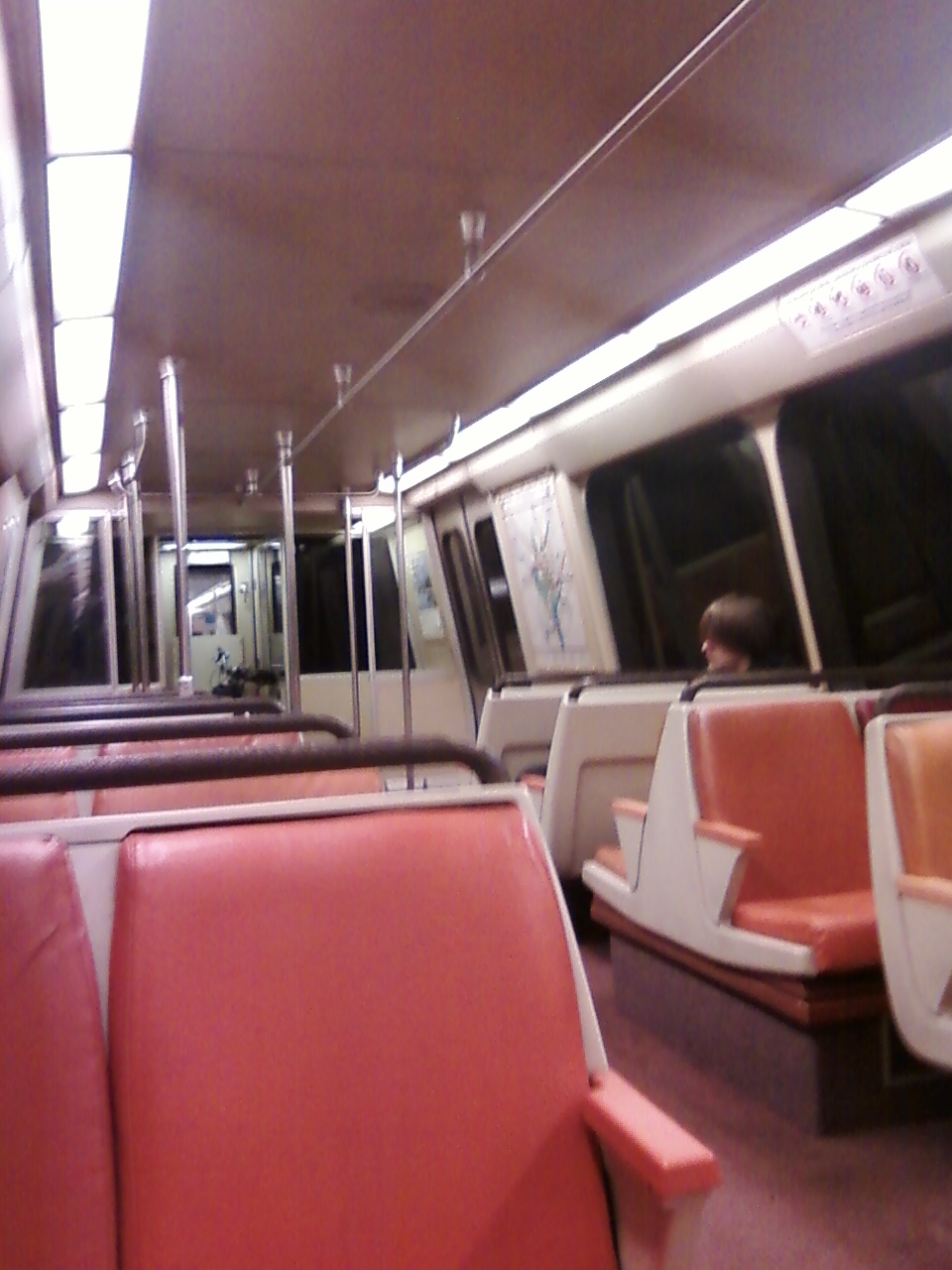
The interior of a typical 1000 series car with padded
seats, carpeting and wind partitions at doors; this is a modified WMATA
1000-Series car, lacking a partition at the right back door in contrast
to the left which maintains the original full partition.
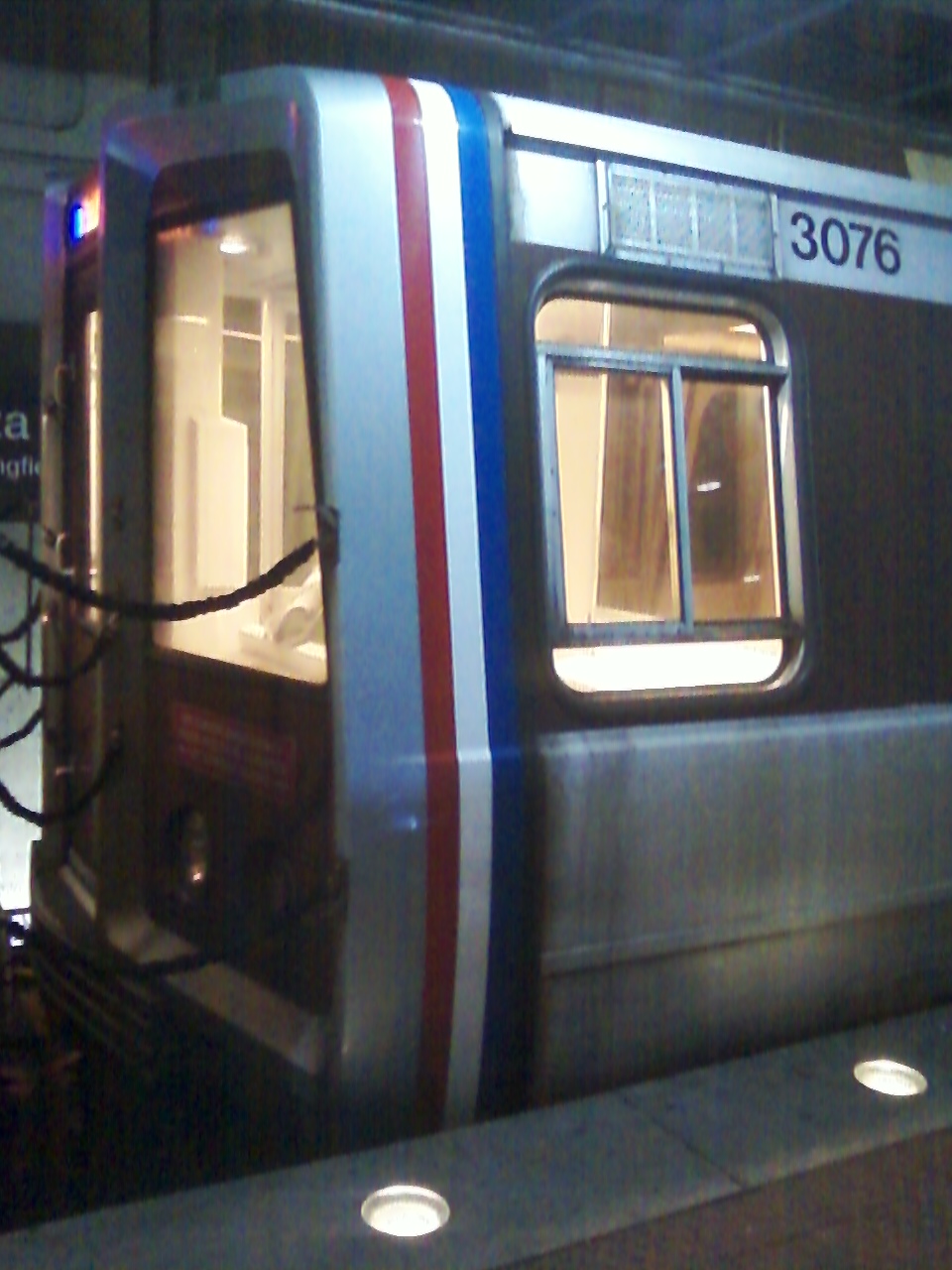
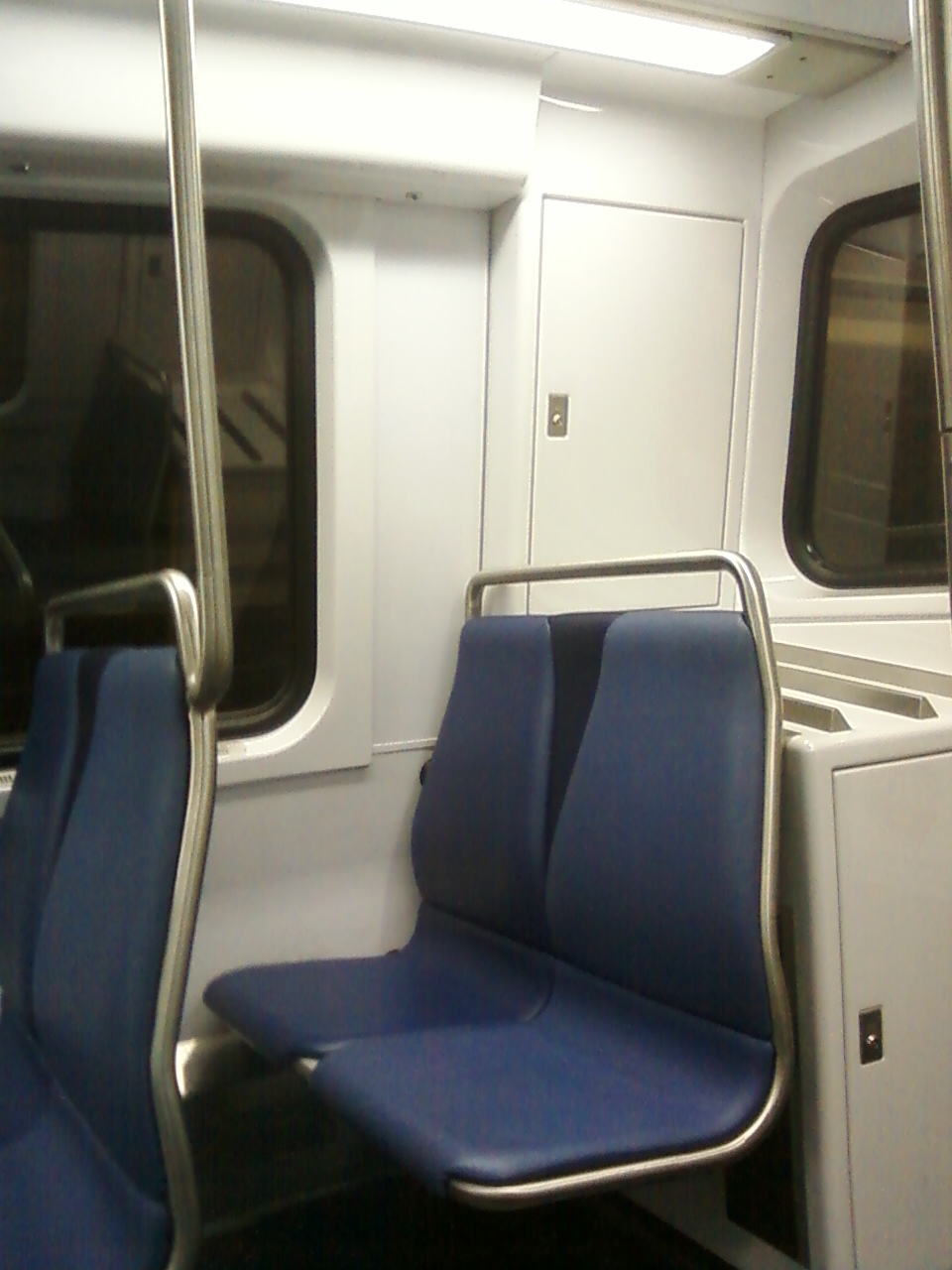
The photo on the left is of a 5000-series 'private section', which is a
pleasant amenity for passengers when the motorman's cab control area is
not used in the given car. The center photo is of the 'private section'
of a 3000-series car; closest to the platform at the window is where
passengers may sit, while further away near the station wall is where the
motorman would be if the train were being operated from the car. The
right photo is where the 'private section' would be on a 7000-series car
if provisions had been made to offer similar seating arrangements;
instead, the 7000 offers fewer seats and no separated/private section.
The isolated and separated two-seat sections immediately adjacent (and
further into the car) of DC Metro car 1183, typical of the 1000 and 2000
series. Note the plastic dividers to isolate the seated passengers from
those standing/leaning at the door area, as well as to protect them from
the weather and elements outdoors. Later model WMATA railcars have have
only one set of two-seats, with somewhat smaller (and less comfortable)
padded seats parallel (instead of perpendicular) to the motorman's cab
seats (not shown), but it too has a divider between it and the doors/main
car body. Note the incandescent door light (rightmost image) which
illuminates when the train doors are open - a much warmer and natural
light than the newer, blue-ish LED lights which are much less effective.
Would it really cost WMATA so much more to use the older, more
visible, incandescent bulbs??
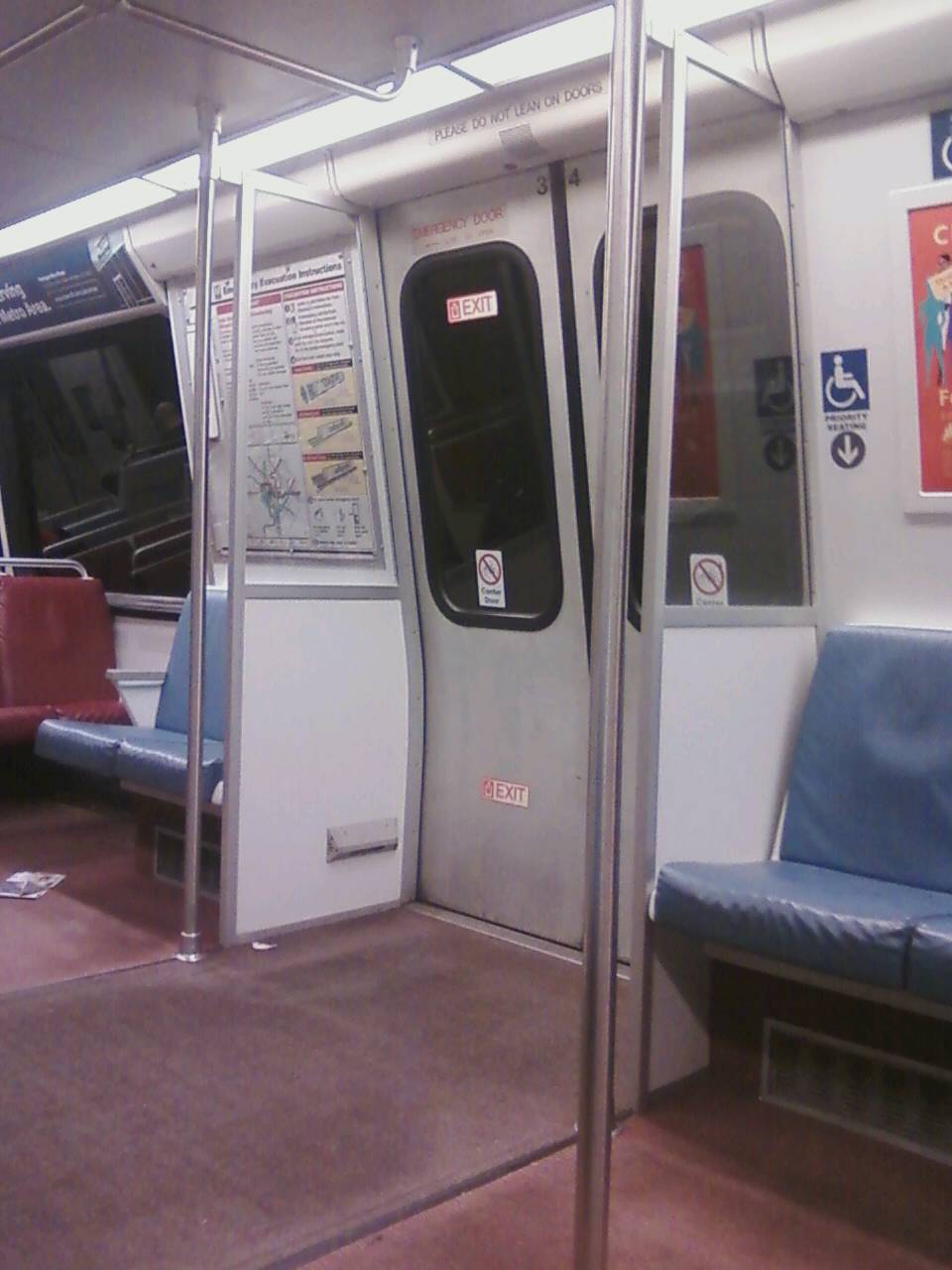
The full door partitions of a 2000 series car. Note the
walkway lights which illuminate the entrance area when the doors open -
another well thought-out amenity from the 1960's/1970's design which has
apparently been dropped in the 7000-series, along with more generally the
full door partitions .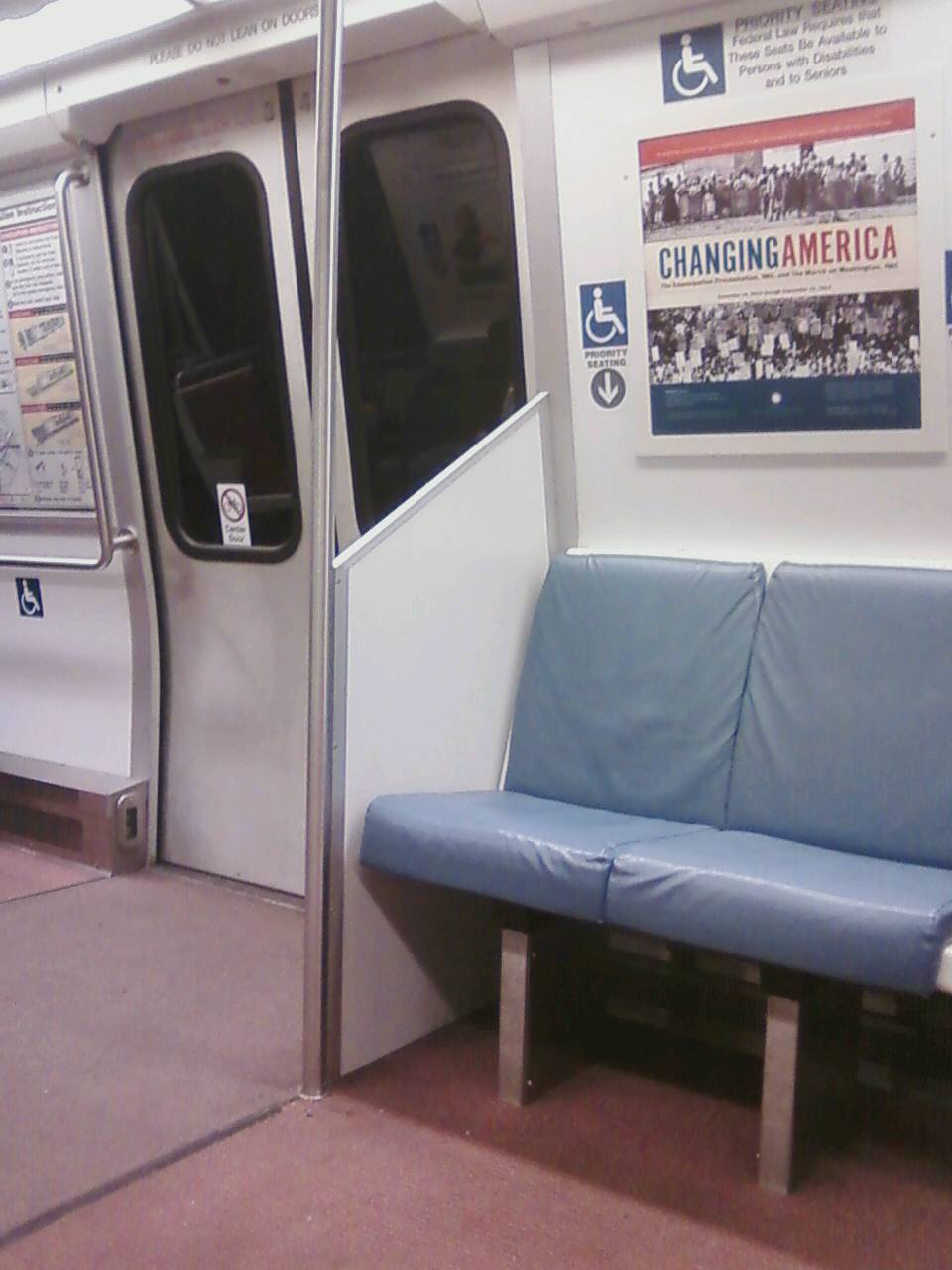
The interior of a 6000 series car lacking a door
partition on the far side (near the wheelchair logo), and an angled or
partial partition on the near side 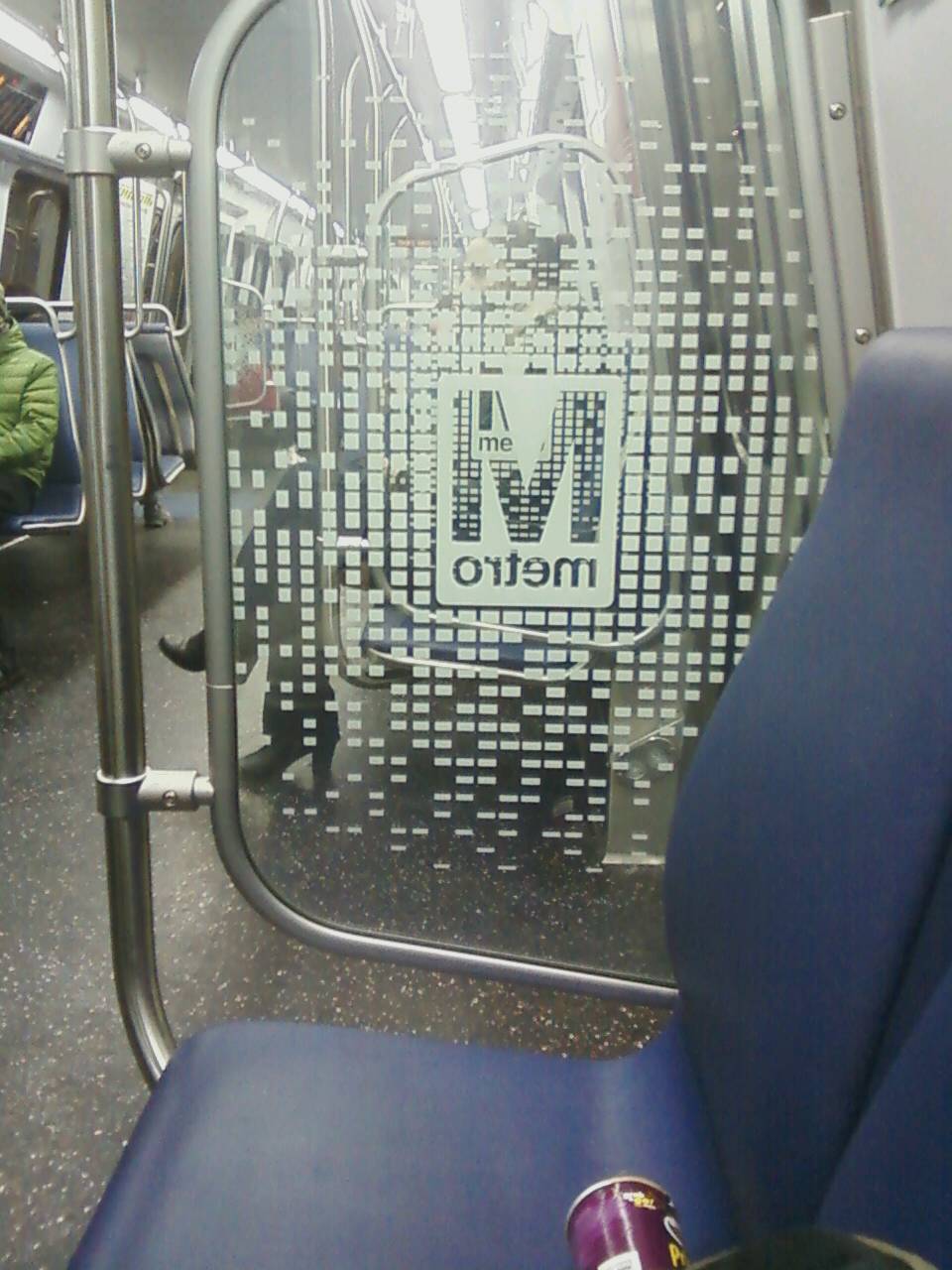

The interior of a 7000 series car's door panel/screen; note
the gaps between the plastic panel and the supporting metal frame, as well
as between the frame and the seating area: This allows for elements from
the outside (wind, rain, extreme temps, etc) to easily enter the car
interior, and affect those seated near the doors much more so than the
solid, ceiling-to-floor panels on the 1000-5000 (and to a lesser extent
6000 series) cars. The interior lighting of the 7000-series is the pallid,
industrial, cool-white fluorescent-ish (really cheap-looking LEDs) variety
seen on some of the modified 6000 series, below. Also note the lack of
carpeting, which no doubt in part results in the 7000 series cars having a
significantly noisier ride. 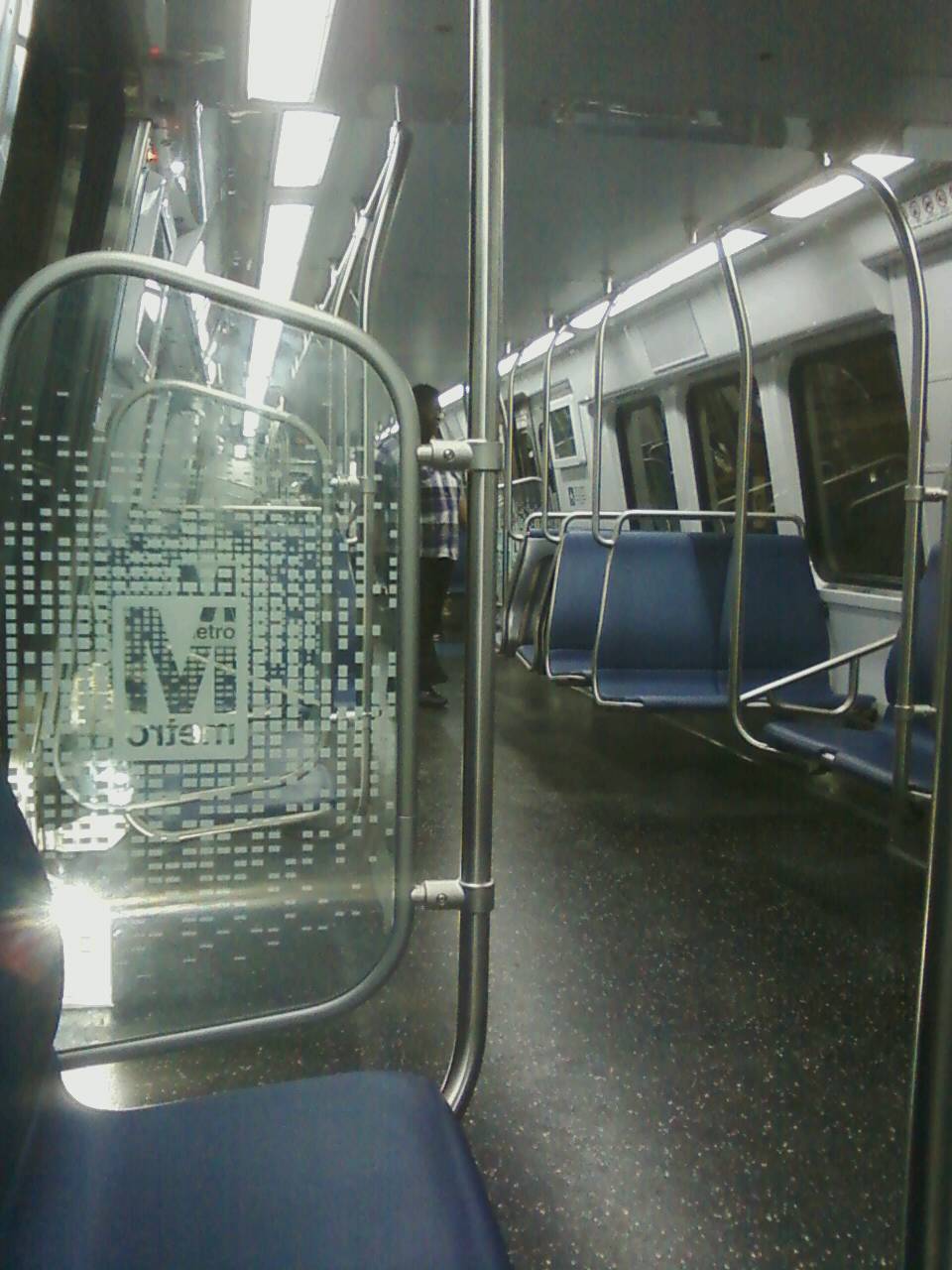
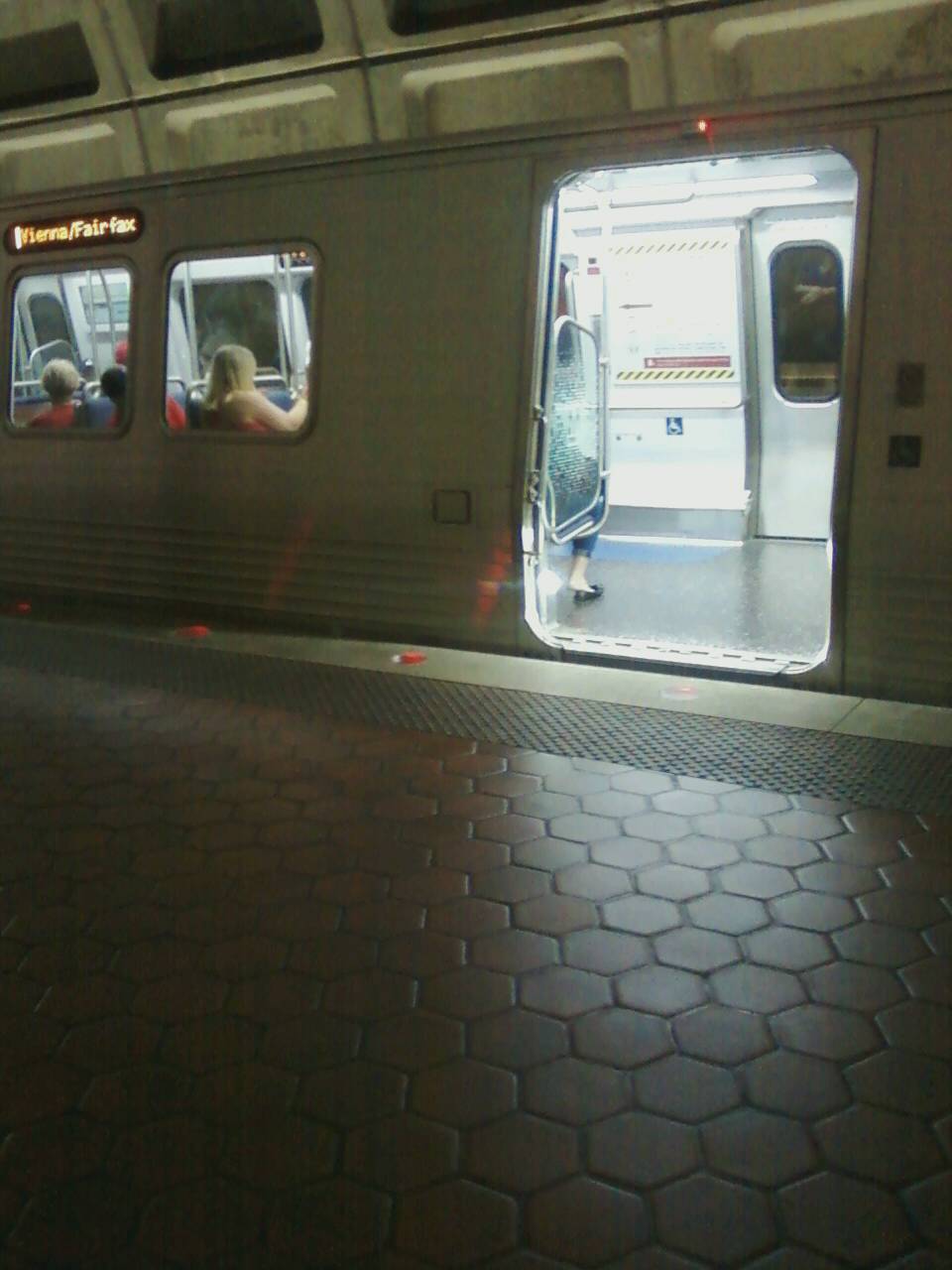
Two more views of the interior of a 7000-series rail car;
the image on the left was taken from the far end inside of a 7000-series
car, while the image on the right was taken while a trainset of 7000 cars
had platformed. Note the door partition does not protect seated
passengers' legs from rain, snow, etc.
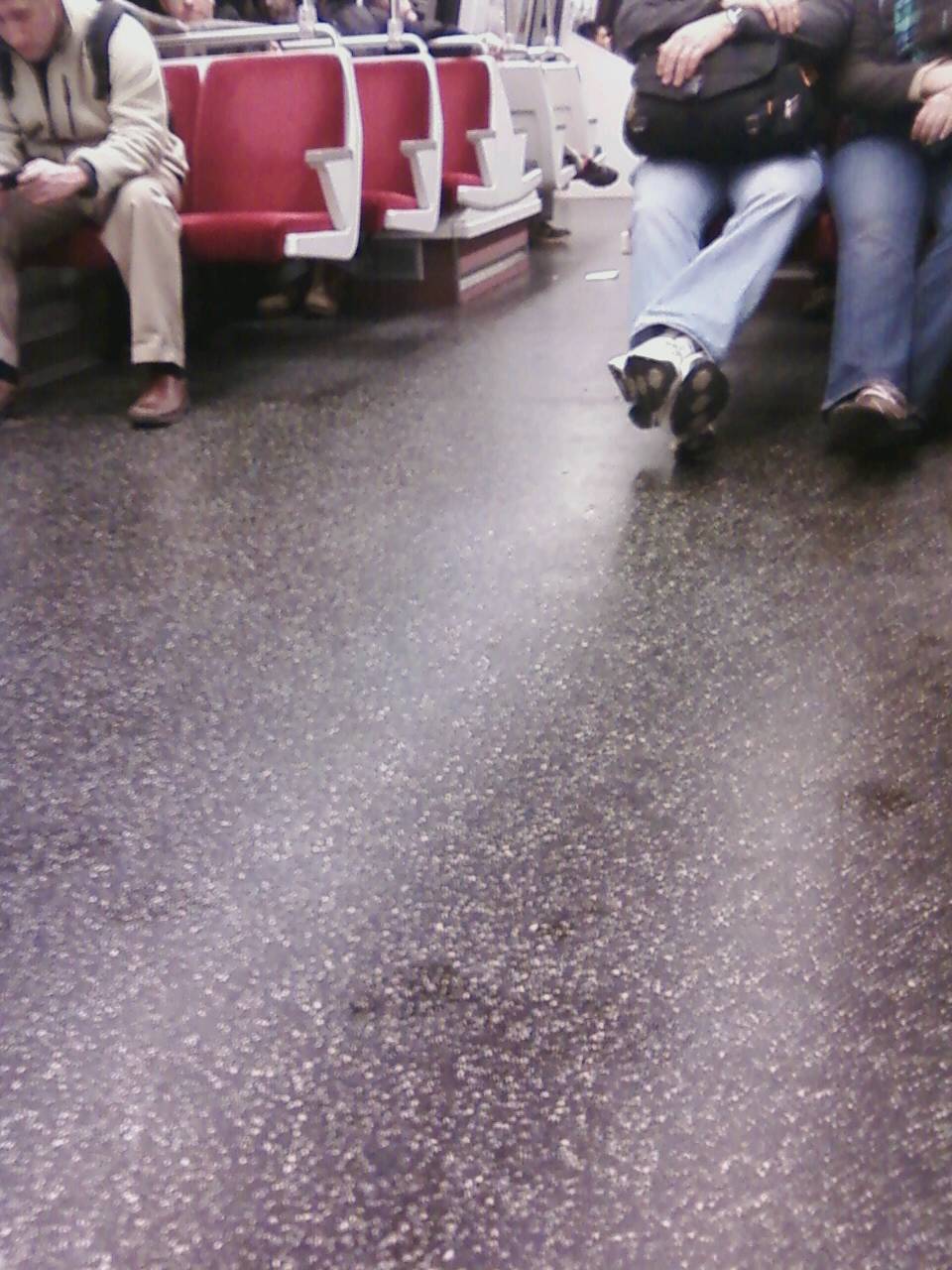
A modified 6000 series car with red velour seats (which is
more than the WMATA 7000 series' small, harder, semi-plastic seats offer),
limited and partial door partition dividers, and no carpeting, which
results in a significantly noisier (and slippery!) ride. Also note the
overpowering and unwelcoming cool-white industrial-looking fluorescent
bulbs in these modified-6000 cars instead of the warm/soft-white varieties
used in most other non-7000 series WMATA railcars.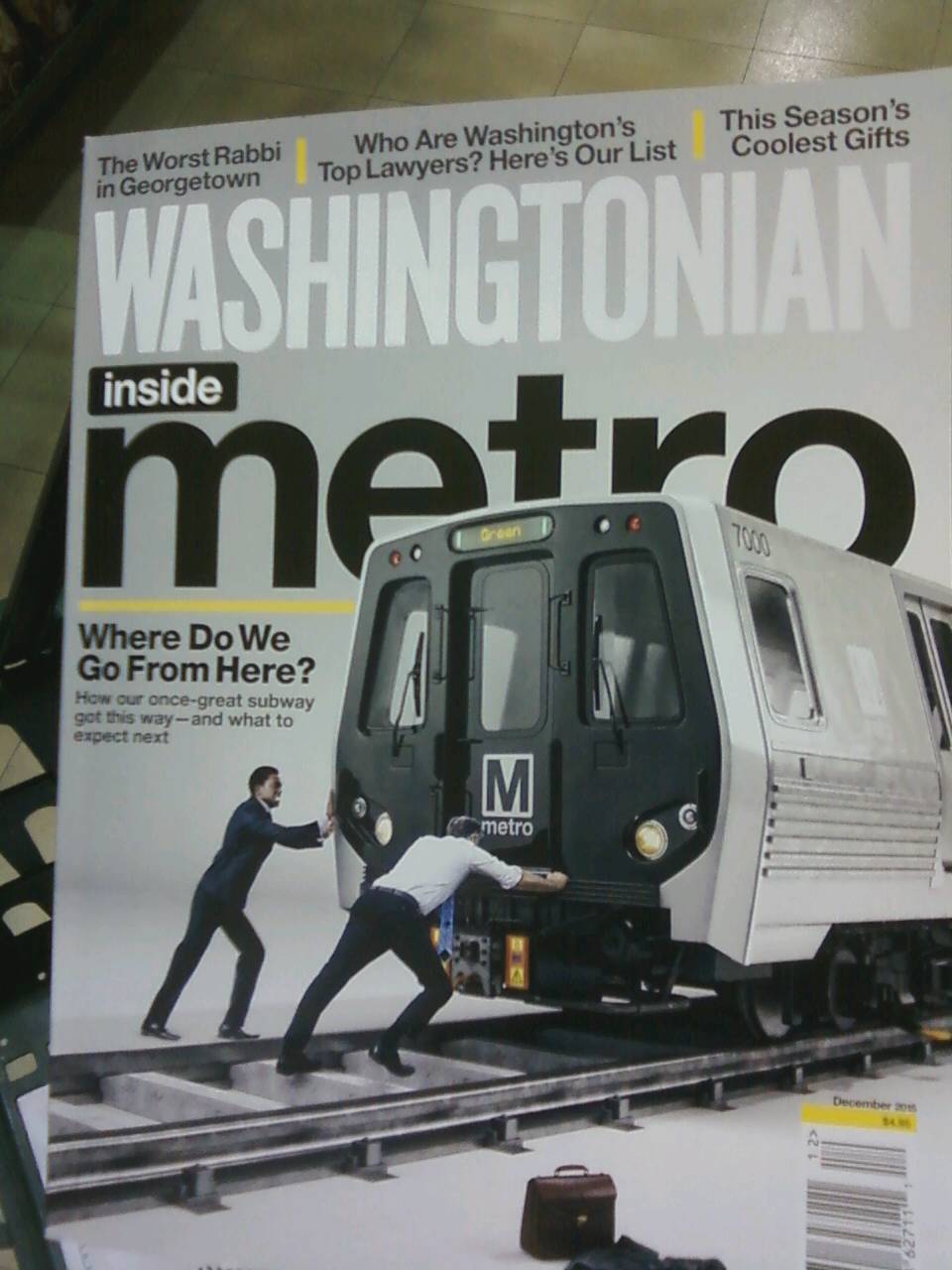
The December 2015 cover of Washingtonian Magazine,
inspiring great confidence in the reliability of the WMATA/Kawasaki 7000
Series Railcars...! :)
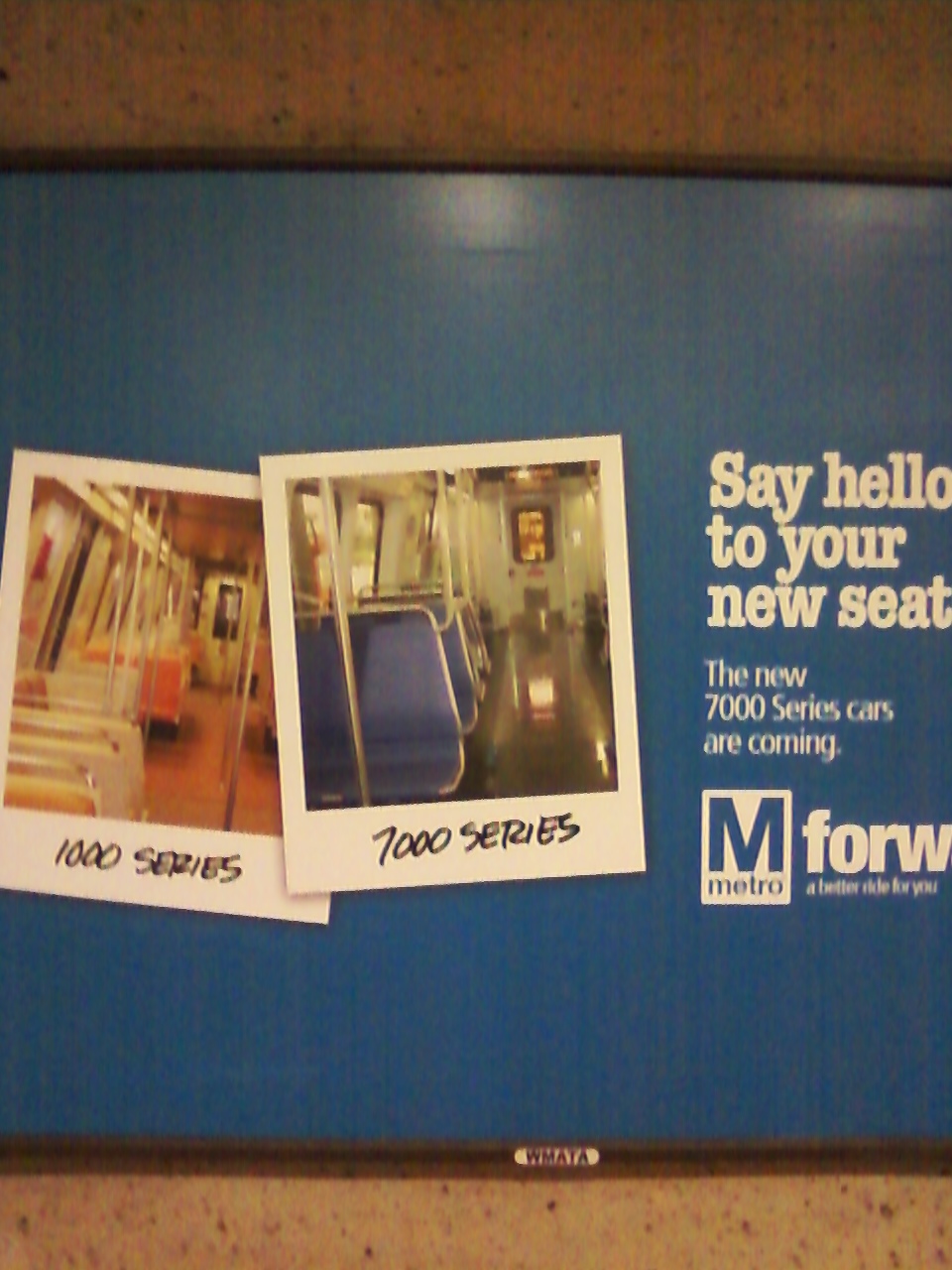
A poster advertising coming 7000 series cars; note the lack
of full door partitions, padded seats, or carpeting, which reduces passenger
comfort and convenience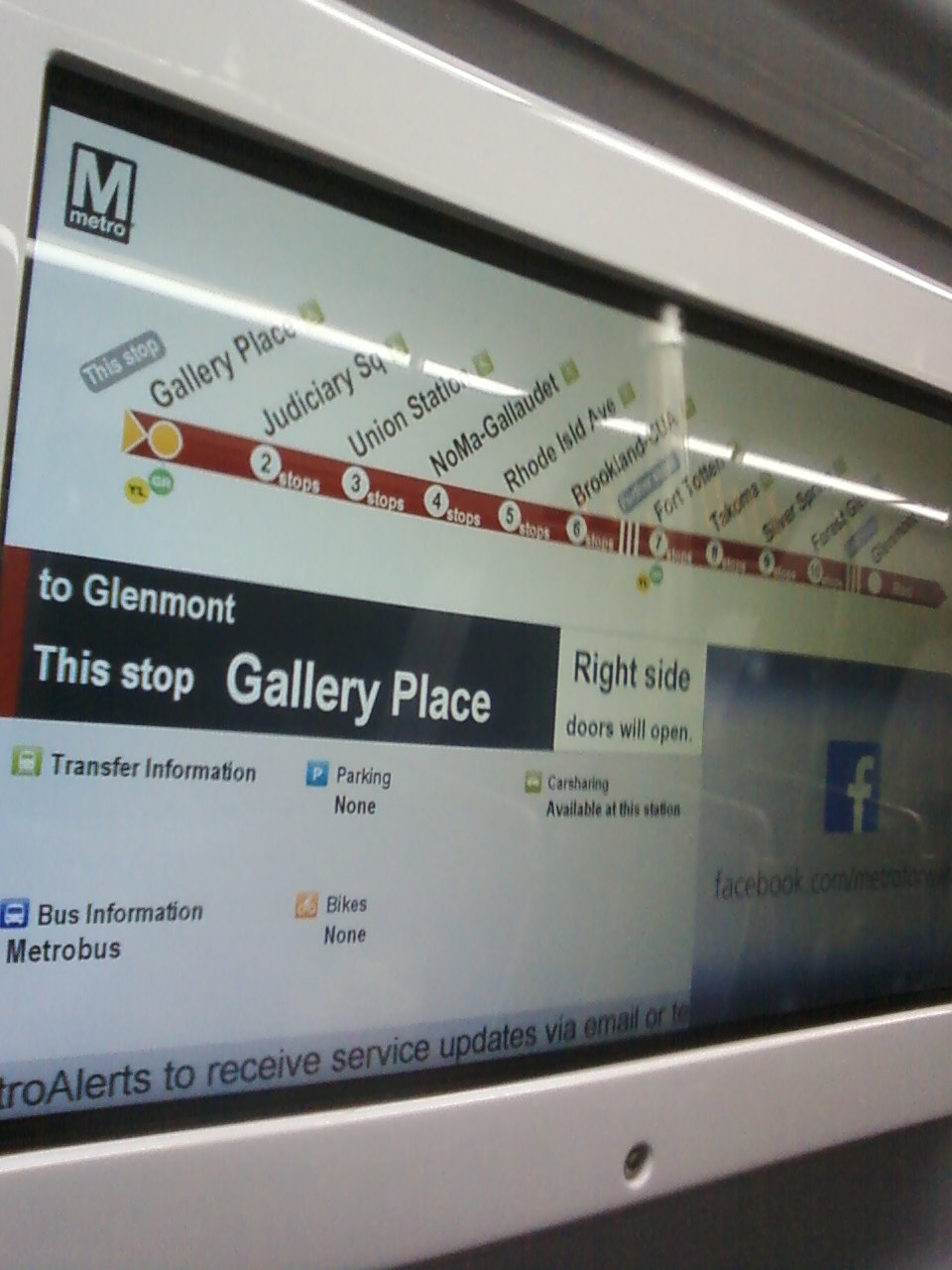
The interior route position/display map on a Red Line 7000
series car, showing the current position, nearest station, and station
services at the given station. While a nice amenity, they are hard to see
from anywhere but right near the map, and do little to alleviate the other
areas in which passenger comfort has been significantly diminished, such
as noisier rides (likely due in part to a lack of carpeting and extensive
padding on the seats and ceilings), lack of proper door screens and
interior partitions, and poor, dim, industrial-looking lighting. It's
relatively easy and cheap to put in a flat panel display and say 'Look how
much we're improving!' (and some of the text on the displays even come
close to iterating that sort of silly mindless cheer-leading!); it's more
costly (somewhat) and harder (also somewhat) to maintain a more comfortable
set of seats, quieter interior ride, and partitioned interior as do the
1000-5000 series cars, yet for years WMATA has been (barely) able to do
so, and the 7000 series cars are just a retreat from this standard since
it appears they just don't want to spend the money needed to maintain the
higher standards which they used to since Metrorail's inception in 1976.
As usual, save money, cut back, and pretend/tell/skew the public
discourse into making it seem like WMATA is making progress.
When the 8000 series comes along, why not just take out the seats and
spread some hay on the floor and be done with it?